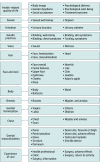Development and Assessment of a Patient-Reported Outcome Instrument for Gender-Affirming Care
- PMID: 40249619
- PMCID: PMC12008761
- DOI: 10.1001/jamanetworkopen.2025.4708
Development and Assessment of a Patient-Reported Outcome Instrument for Gender-Affirming Care
Abstract
Importance: There is an urgent need for a validated gender-affirming care-specific patient-reported outcome measure (PROM).
Objective: To field test the GENDER-Q, a new PROM for gender-affirming care, in a large, international sample of transgender and gender diverse (TGD) adults and evaluate its psychometric properties.
Design, setting, and participants: This international cross-sectional study was conducted among TGD adults aged 18 years and older who were seeking or had received gender-affirming care within the past 5 years at 21 clinical sites across Canada, the United States, the Netherlands, and Spain; participants were also recruited through community groups (eg, crowdsourcing platform, social media). The study was conducted between February 2022 and March 2024. Participants had to be capable of completing the instrument in English, Danish, Dutch, or French-Canadian. Eligible participants accessed an online REDCap survey to complete sociodemographic questions and questions about gender-affirming care they had received or sought (ie, to look, function, or feel masculine, feminine, gender fluid, or another way).
Main outcome and measures: Branching logic was used to assign relevant instrument scales. Rasch measurement theory (RMT) analysis was used to examine the fit of the observed data to the Rasch model for each scale. Test-retest reliability and hypothesis-based construct validity of instrument scales were examined. The hypothesis was that instrument scale scores would increase with better outcomes on corresponding categorical questions.
Results: A total of 5497 participants (mean [SD] age, 32.8 [12.3] years; 1837 [33.4%] men; 1307 [23.8%] nonbinary individuals; and 2036 [37.0%] women) completed the field test survey. Participants sought or had the following types of gender-affirming care: 2674 (48.6%) masculinizing, 2271 (41.3%) femininizing, and 552 (10.0%) other. RMT analysis led to the development of 54 unidimensional scales and 2 checklists covering domains of health-related quality of life, sexual, urination, gender practices, voice, hair, face and neck, body, breasts, genital feminization, chest, genital masculinization, and experience of care. Test-retest reliability of the scales (intraclass correlation coefficient [average] >0.70) was demonstrated. Only 1 item (phalloplasty donor flap) had an ICC less than 0.70. As hypothesized, scores increased incrementally with better associated self-reported categorical responses. For example, among 661 participants who reported poor psychological well-being, the mean (SD) scale score was 45 (18) points; for those who reported excellent psychological well-being, the mean (SD) scale score was 85 (16) points (P < .001).
Conclusions and relevance: In this cross-sectional study of 5497 TGD adults, the instrument demonstrated reliability and validity. The instrument was validated in an international sample and is designed to collect and compare evidence-based outcome data for gender-affirming care from the patients' perspective.
Conflict of interest statement
Figures
References
-
- World Health Organization . Gender incongruence and transgender health in the ICD. Accessed June 12, 2024. https://www.who.int/standards/classifications/frequently-asked-questions...
-
- US Food and Drug Administration . Guidance for industry: patient-reported outcome measures: use in medical product development to support labeling claims. December 2009. Accessed May 12, 2024. https://www.fda.gov/media/77832/download
-
- Aiyegbusi OL, Hughes SE, Calvert MJ. The role of patient-reported outcomes (PROs) in the improvement of healthcare delivery and service. In: Kassianos AP, ed. Handbook of Quality of Life in Cancer. Springer; 2022:339-352.
Publication types
MeSH terms
Grants and funding
LinkOut - more resources
Full Text Sources
Research Materials
Miscellaneous



